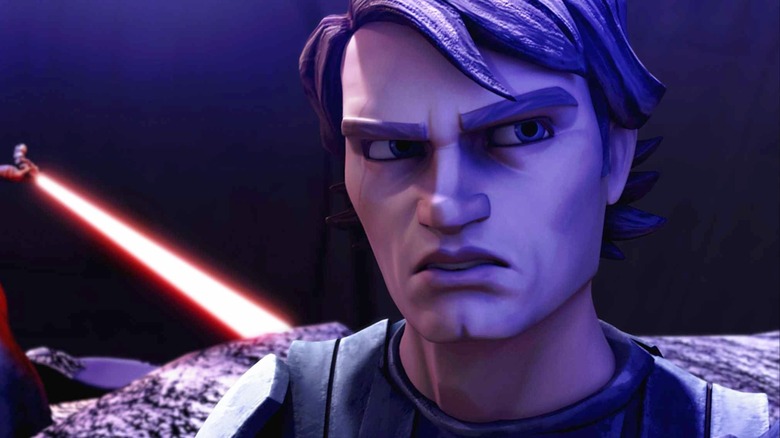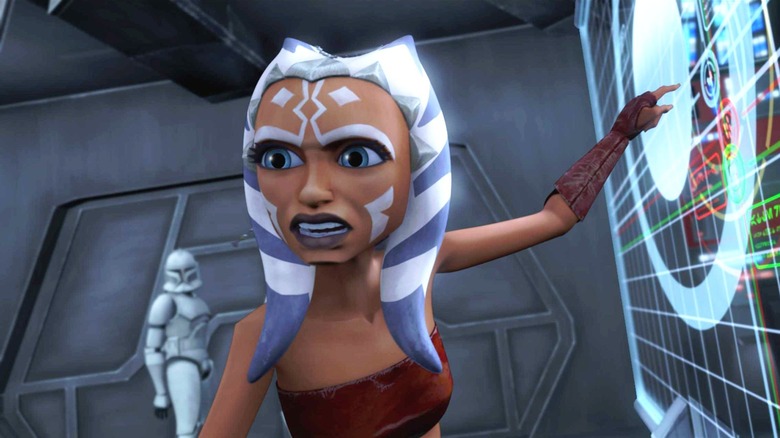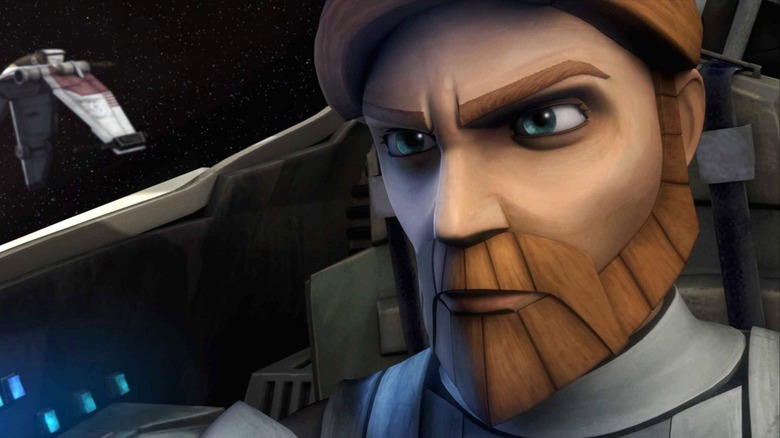George Lucas Had To Promise A Star Wars Movie To Sell The Clone Wars To Cartoon Network
"Star Wars" was in a strange place in 2007. Two years out from the release of "Revenge of the Sith," George Lucas' mega-lucrative prequel trilogy had yet to undergo the critical re-evaluation it would receive over the decades that followed its conclusion. At the time, people were (not unfairly) still a little too hung up on their clumsier and weirdly affectless narrative elements to fully appreciate just how shockingly insightful the films are when it comes to their commentary on U.S. politics and the ways history keeps repeating itself. It would also be another five years before Disney acquired Lucasfilm, at which point the "Star Wars" franchise would see a dramatic re-tooling in terms of its over-arching storytelling and thematic design.
Why, then, is 2007 a significant year for a galaxy far, far away? You see, dear reader, this was when Lucas began pitching "Star Wars: The Clone Wars" to TV networks, having spent the previous two years developing the animated series. The show takes place between the events of "Attack of the Clones" and "ROTS" — gotta love that acronym — and was the first major project developed by Lucasfilm Animation after its founding in 2003. Hoping to continue telling "Star Wars" stories in animation, Lucas assembled what the New York Times described in 2008 as "a team of young 'Star Wars'-obsessed artists who revere Mr. Lucas as if he were Yoda himself." (They weren't wrong!) That included the division's future creative head honcho, Dave Filoni, who was then hot off his work as a storyboard artist and character designer on "Avatar: The Last Airbender."
There was just one problem: nobody wanted to pick up the (nowadays widely acclaimed) "Clone Wars" show. Not without an additional commitment on Lucas' part, anyhow.
Attack of the Clone Wars(es)
Dave Filoni's experience on "The Last Airbender" came in handy with "The Clone Wars," a computer-animated series that embraced a similar anime-inspired aesthetic. This would stand in contrast to later cartoon shows like "Star Wars Rebels," which took its cues from the rounder designs and earthy tones of Ralph McQuarrie's conceptual art for the original "Star Wars" film trilogy. More pertinent to this discussion, this set "The Clone Wars" even further apart visually from "Star Wars: Clone Wars," a short 2D animated series developed by Genndy Tartakovsky and realized in a highly kinetic, harder-edged style reminiscent of the animation maestro's other action-driven, dialogue-sparse creations like "Samurai Jack" and eventually "Primal."
Despite having broadcast Tartakovsky's animated "Star Wars" short series from 2003 to 2005 (or perhaps because they aired it), the NY Times described Cartoon Network as originally being "lukewarm" on "The Clone Wars." Fox Broadcasting, whose sister company had released George Lucas' original and prequel film trilogies in theaters, wasn't biting either, even with most of the show's first 22-episode season already nearly done. It's certainly possible the initial response to Lucas' prequel films was to blame, although the filmmaker himself felt it had more to do with the show's tone. "It didn't fit any of the molds that everybody had. It's not 'SpongeBob SquarePants,' but at the same time it's also not 'Family Guy,'" he reasoned.
Lucas had a point. "The Clone Wars" started out way more kid-friendly and light-hearted than it became in later seasons, but at its core it was always a show about war and the toll it takes on civilizations. Slapstick-y droid antics and clownish alien villains could only do so much to lighten the sights of terrified civilians being taken hostage by aggressive robo-soldiers or desperately fleeing active combat zones.
When a movie's not really a movie
Cartoon Network would ultimately come around to acquiring "The Clone Wars" after some convincing from its corporate overlords at Warner Bros. There was, however, a catch: WB only got onboard after George Lucas agreed to produce a theatrical "Clone Wars" feature first. "It's the relationship with Lucasfilm that we're very excited about," said Dan Fellman, WB's then-president for domestic distribution. "Not just on the Cartoon Network but possibly for live-action television down the road." Yeah, that didn't happen, but WB certainly wasn't wrong for being giddy about the commercial prospect of live-action "Star Wars" television.
As for the "Clone Wars" movie? It's pretty blatantly not a movie at all but the first three episodes of the show smushed together to fill out a feature-length runtime. Critics and audiences has little trouble seeing through the charade, with Roger Ebert dismissing the film (which Dave Filoni received credit for directing) as "basically just a 98-minute trailer for the autumn launch of a new series on the Cartoon Network." Had it aired as a three-part pilot, reviews probably would've been kinder when it came to the still-rough early animation and lack of narrative substance. With the benefit of hindsight, though, it's rather difficult not to suspect Lucas only made it to fulfill his obligation to WB.
Overall, though, it was a fair trade. By setting up shop at Cartoon Network, "The Clone Wars" was afforded the room it needed to come into its own, fleshing out characters and ideas from Lucas' prequel trilogy (thereby lending greater dimensions to the films in the process) and proving "Star Wars" animation could be just as good — and often better — than the live-action projects. All it took was a somewhat phoned-in "movie" to seal the deal.


